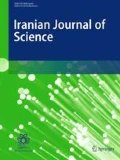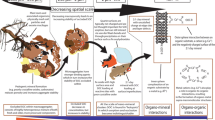Abstract
Microbially induced calcium carbonate precipitation (MICP) is an abundant process in nature and involves the microorganism's activities. Therefore, our aim was to characterize the crystals precipitated by locally isolated urease-producing bacteria (Sporosarcina pasteurii N4, Lysinibacillus boronitolerance N6, Bacillus sp. N2, and Bacillus sp. N5) and to evaluate their resistance under extreme conditions. The Fourier transform infrared spectroscopy analysis confirmed the presence of calcium carbonate in the precipitates. The X-ray diffraction analysis demonstrated that calcite is the dominant polymorph produced using strains. The scanning electron microscope micrograph showed that precipitated calcium carbonate was in the shape of nanocrystal aggregates. The size of particles ranged between 20 and 50 nm. All survived strains were halotolerant and were able to grow in acidic and alkaline medium, but at an optimal pH level of 7. Bacterial growth obtained in the temperature range of 20–47 °C. Also, they showed 44–70% viability after 28-day desiccation stress using flow cytometry. These local bacteria can tolerate extreme conditions as well as production of calcium carbonate, and this suggests that four local strains are suitable candidates for the MICP applications. They can be a good alternative to conventional methods in the soil stabilization and other MICP-related applications.






Similar content being viewed by others
References
Akond MA, Jahan MN, Sultana N, Rahman F (2016) Effect of temperature, pH and NaCl on the isolates of Actinomycetes from straw and compost samples from Savar, Dhaka, Bangladesh. Am J Microbiol Immunol 1:10–15
Castro-Alonso MJ, Montañez-Hernandez LE, Sanchez-Muñoz MA, Macias Franco MR, Narayanasamy R et al (2019) Microbially induced calcium carbonate precipitation (MICP) and its potential in bioconcrete: microbiological and molecular concepts. Front Mater 6:126. https://doi.org/10.3389/fmats.2019.00126
Chen M, Gowthaman S, Nakashima K, Komatsu S, Kawasaki S (2021) Experimental study on sand stabilization using bio-cementation with wastepaper fiber integration. Materials 14:5164
Dhami NK, Reddy MS, Mukherjee A (2013) Biomineralization of calcium carbonate polymorphs by the bacterial strains isolated from calcareous sites. J Microbiol Biotechnol 23:707–714. https://doi.org/10.3390/ma14185164
Dikshit R, Jain A, Dey A, Kumar A (2020) Microbially induced calcite precipitation using Bacillus velezensis with guar gum. PLoS ONE 15:e0236745. https://doi.org/10.1371/journal.pone.0236745
Dubey AA, Ravi K, Mukherjee A, Sahoo L, Abiala MA et al (2021) Biocementation mediated by native microbes from Brahmaputra riverbank for mitigation of soil erodibility. Sci Rep 11:1–15. https://doi.org/10.1038/s41598-94614-6
Elmanama AA, Alhour M (2013) Isolation, characterization and application of calcite producing bacteria from urea rich soils. J Adv Sci Eng Res 3:377–399
Elmi F, Etemaifar Z, Emtiazi G (2022) Biosynthesis of calcite nanocrystal by a novel polyextremophile Bhargavaea cecembensis-related strain isolated from sandy soil. Microb Ecol. https://doi.org/10.1107/s00248-022-01977-y
Ghezelbash GR, Haddadi M (2018) Production of nanocalcite crystal by a urease producing halophilic strain of Staphylococcus saprophyticus and analysis of its properties by XRD and SEM. World J Microbiol Biotechnol 34:174. https://doi.org/10.1007/s11274-018-2544-2
Gholami M, Etemadifar Z (2015) Isolation and characterization of a novel strain of genus Dietzia capable of multiple-extreme resistance. Microbiology 84:389–397. https://doi.org/10.1134/s00262617155030054
Han Z, Wang J, Zhao H, Tucker ME, Zhao Y et al (2019) Mechanism of biomineralization induced by Bacillus subtilis J2 and characteristics of the biominerals. Minerals 9:218. https://doi.org/10.3390/min9040218
Hommel J, Akyel A, Frieling Z, Phillips AJ, Gerlach R et al (2020) A numerical model for enzymatically induced calcium carbonate precipitation. Appl Sci 10:4538. https://doi.org/10.3390/app10134538
Jung Y, Kim W, Kim W, Park W (2020) Complete genome and calcium carbonate precipitation of alkaliphilic Bacillus sp. AK13 for self-healing concrete. https://doi.org/10.4014/jmb.1908.08044
Khan I, Rafiq M, Zada Z, Jamil SUU, Hasan F (2021) Calcium carbonate precipitation by rock dwelling bacteria in Murree Hills, Lower Himalaya Range Pakistan. Geomicrobiol J 38:231–236. https://doi.org/10.1080/01490451.2020.1836085
Kim HJ, Eom HJ, Park C, Jung J, Shin B et al (2016) Calcium carbonate precipitation by Bacillus and Sporosarcina strains isolated from concrete and analysis of the bacterial community of concrete. J Microbiol Biotechnol 26:540–548. https://doi.org/10.4014/jmb.1511.11008
Krajewska B (2018) Urease-aided calcium carbonate mineralization for engineering applications: A review. J Adv Res 13:59–67. https://doi.org/10.1016/j.jare.2017.10.009
Krishnapriya S, Babu DV (2015) Isolation and identification of bacteria to improve the strength of concrete. Microbiol Res 174:48–55. https://doi.org/10.1016/j.micres.2015.03.009
Liu X, Zarfel G, Van der Weijden R, Loiskandl W, Bitschnau B (2021) Density-dependent microbial calcium carbonate precipitation by drinking water bacteria via amino acid metabolism and biosorption. Water Res 202:117444. https://doi.org/10.1016/j.waters.2021.117444
Mathur S, Bhatt A, Patel R (2018) Role of microbial induced calcite precipitation in sustainable development. Ann Biol Res 9:11–27
Mokhtar G, Ahmed AAEA, Reyad AM (2021) The effect of isolated Bacillus ureolytic bacteria in improving the bio-healing of concrete cracks. Beni-Suef Univ J Basic Appl Sci 10:1–10. https://doi.org/10.1186/s43088-021-00142-7
Mutitu DK, Wachira JM, Mwirichia R, Thiong’o JK, Munyao OM et al (2019) Influence of Lysinibacillus sphaericus on compressive strength and water sorptivity in microbial cement mortar. Heliyon 5:e02881. https://doi.org/10.1016/j.heliyon.2019.e02881
Ortega-Villamagua E, Gudiño-Gomezjurado M, Palma-Cando A (2020) Microbiologically induced carbonate precipitation in the restoration and conservation of cultural heritage materials. Molecules 25:5499. https://doi.org/10.3390/molecules25235499
Osinubi K, Eberemu A, Ijimdiya T, Yakubu S, Gadzama E et al (2020) Review of the use of microorganisms in geotechnical engineering applications. SN Appl Sci 2:1–19. https://doi.org/10.1007/s42452-020-1974-2
Rajasekar A, Moy CK, Wilkinson S (2017) MICP and advances towards eco-friendly and economical applications. IOP Conf Ser Earth Environ Sci. https://doi.org/10.1088/1755-1315/78/1/012016
Rajasekar A, Moy CK, Wilkinson S, Sekar R (2021) Microbially induced calcite precipitation performance of multiple landfill indigenous bacteria compared to a commercially available bacteria in porous media. PLoS ONE 16:e0254676. https://doi.org/10.1371/journal.pone.0254676
Rajasekar A, Wilkinson S, Sekar R, Bridge J, Medina-Roldan E et al (2018) Biomineralisation performance of bacteria isolated from a landfill in China. Can J Microbiol 64:945–953. https://doi.org/10.1139/cjm-2018-0254
Susilowati P, Ardianti D, Kartini S, Sudiana I, Zaeni A (2021) Isolation of ureolytic bacteria of soft coral and their potential in microbially induced calcite precipitation (MICP). J Phys Conf Ser. https://doi.org/10.1088/1742-6596/1899/1/012003
Tayyem NEA, Elhello KT, Elmanama AA (2021) Isolation, identification and growth conditions of calcite producing bacteria from urea-rich soil. Afr J Microbiol Res 15:37–46. https://doi.org/10.5897/AJMR2020.9445
Vashisht R, Attri S, Sharma D, Shukla A, Goel G (2018) Monitoring biocalcification potential of Lysinibacillus sp. isolated from alluvial soils for improved compressive strength of concrete. Microbiol Res 207:226–231. https://doi.org/10.1016/j.micres.2017.12.010
Wang Z, Zhang N, Ding J, Lu C, Jin Y (2018) Experimental study on wind erosion resistance and strength of sands treated with microbial-induced calcium carbonate precipitation. Adv Mater Sci Eng. https://doi.org/10.1155/2018/3463298
Wei S, Cui H, Jiang Z, Liu H, He H et al (2015) Biomineralization processes of calcite induced by bacteria isolated from marine sediments. Braz J Microbiol 46:455–464. https://doi.org/10.1590/S1517-838246220140533
Whitaker JM, Vanapalli S, Fortin D (2018) Improving the strength of sandy soils via ureolytic CaCO3 solidification by Sporosarcina ureae. Biogeosciences 15:4367–4380. https://doi.org/10.5194/bg-15-4367-2018
Zhu T, Dittrich M (2016) Carbonate precipitation through microbial activities in natural environment, and their potential in biotechnology: a review. Front Bioeng Biotechnol 4:4. https://doi.org/10.3389/fbioe.2016.00004
Acknowledgements
We are most thankful to the University of Isfahan for the financial support of this work.
Funding
This work was supported by a grant from the University of Isfahan, Iran.
Author information
Authors and Affiliations
Contributions
All authors contributed to the study conception and design. Material preparation, data collection and analysis were performed by FE. The first draft of the manuscript was written by FE, and all authors commented on previous version of the manuscript. All authors read and accept submission of the manuscript to this journal.
Corresponding author
Ethics declarations
Conflict of interest
The authors have no relevant financial interests to disclose.
Rights and permissions
Springer Nature or its licensor holds exclusive rights to this article under a publishing agreement with the author(s) or other rightsholder(s); author self-archiving of the accepted manuscript version of this article is solely governed by the terms of such publishing agreement and applicable law.
About this article
Cite this article
Elmi, F., Etemadifar, Z. & Emtiazi, G. Calcite Nanocrystal Production Using Locally Isolated Ureolytic Bacteria and Assessing Their Resistance to Extreme Conditions. Iran J Sci Technol Trans Sci 46, 1523–1530 (2022). https://doi.org/10.1007/s40995-022-01366-7
Received:
Accepted:
Published:
Issue Date:
DOI: https://doi.org/10.1007/s40995-022-01366-7




